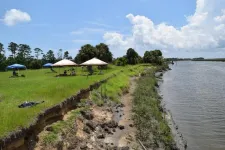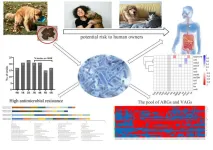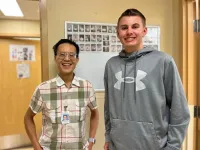(Press-News.org) Countries in the European Union (EU) have made progress over the past decade toward Sustainable Development Goal 7 (SDG 7), which calls for “access to affordable, reliable, sustainable and modern energy for all” by 2030, according to a study published February 28, 2024 in the open-access journal PLOS ONE by Marek Walesiak from Wroclaw University of Economics and Business, Poland, and Grażyna Dehnel from Poznań University of Economics and Business, Poland.
In 2015, the United Nations developed 17 global Sustainable Development Goals to be achieved by 2030. Tenets of SDG 7 include universal access to affordable energy; increased renewable energy in developing countries; and international clean energy research. Seven key metrics, called indicators, are used to quantify countries’ progress toward the broad aim.
Walesiak and Dehnel measured 27 EU countries’ progress toward SDG 7 between 2010 and 2021, using data provided by Eurostat. EU countries assessed included Croatia and excluded the United Kingdom. The researchers captured each country’s position relative to the 2030 targets, including progress made and distance still to go. To adjust for differences among countries, the researchers adopted a new-to-the-field method called dynamic relative taxonomy.
Data demonstrated that EU countries made progress toward the SDG 7 targets from 2010-2021, both individually and collectively. The researchers found that Sweden came closest to achieving SDG 7 goals in 2021, followed by Denmark and Estonia; Bulgaria was furthest from the goal. Malta, which in 2010 was furthest from the 2030 targets, made the greatest progress toward SDG 7. Latvia displayed the largest leap in rankings, jumping from 19th to 8th place.
In 2021, several countries had already achieved 2030 targets for one or more of SDG 7’s key indicators. For example: Sweden, Finland, and Latvia surpassed the 40% target for the indicator: “Share of renewable energy in gross final energy consumption.” The researchers credit this to hydropower and biofuels.
The researchers state that all indicators must be closely and continuously monitored to ensure the EU achieves its SDG 7 goals by 2030. Noting the potential impact of the COVID-19 pandemic, they acknowledge that sixteen countries experienced deterioration in their progress from 2020-2021.
The authors add: “The aim of the study is to assess progress towards meeting SDG 7 (“Ensure access to affordable, reliable, sustainable and modern energy for all”) by individual EU countries in 2010-2021, and to determine their distance in relation to the target set for 2030. In order to limit the impact of the compensation effect on the ranking of EU countries, we applied dynamic relative taxonomy with the geometric mean to create an aggregate measure that takes into account target values for the indicators with adjusted data.”
#####
In your coverage please use this URL to provide access to the freely available article in PLOS ONE: https://journals.plos.org/plosone/article?id=10.1371/journal.pone.0297856
Citation: Walesiak M, Dehnel G (2024) Progress on SDG 7 achieved by EU countries in relation to the target year 2030: A multidimensional indicator analysis using dynamic relative taxonomy. PLoS ONE 19(2): e0297856. https://doi.org/10.1371/journal.pone.0297856
Author Countries: Poland
Funding: The possibility of funding for publication within the 'Regional Initiative for Excellence programme of the Minister of Education and Science of Poland, years 2019-2023” (grant no. 004/RID/2018/19) ended at the end of 2023. Currently, the publication can be funded by two universities: Uniwersytet Ekonomiczny w Poznaniu (50%) and Uniwersytet Ekonomiczny we Wrocławiu (50%). The funder does not play any role in the study design, data collection and analysis, decision to publish, or preparation of the manuscript.
END
EU countries have seen a decade of progress towards their 2030 sustainable energy goal
Sweden, Denmark, and Estonia are closest to the 2030 benchmark; Malta is most improved while Bulgaria has furthest to go
2024-02-28
ELSE PRESS RELEASES FROM THIS DATE:
Climate change threatens thousands of archaeological sites in coastal Georgia
2024-02-28
Thousands of historic and archaeological sites in Georgia are at risk from tropical storm surges, and that number will increase with climate change, according to a study published February 28, 2024 in the open-access journal PLOS ONE by Matthew D. Howland and Victor D. Thompson of Wichita State University and the University of Georgia.
Anthropogenic climate change poses a major risk to coastlines due to rising sea level and increasingly severe tropical storms. This threatens not only living populations but also historic and archaeological sites. Mitigating damage requires accurate assessments of risks, but most predictive models focus on projected ...
Pet dogs with diarrhea may be shedding multi-drug resistant E.coli in 5 in 10 cases, with potential risks to their human owners
2024-02-28
Pet dogs with diarrhea may be shedding multi-drug resistant E.coli in 5 in 10 cases, with potential risks to their human owners
###
Article URL: https://journals.plos.org/plosone/article?id=10.1371/journal.pone.0298053
Article Title: Characteristics of MDR E. coli strains isolated from Pet Dogs with clinic diarrhea: A pool of antibiotic resistance genes and virulence-associated genes
Author Countries: China
Funding: This research was funded by the National Key Research and Development Program of China (2018YFD0500900, ...
Harassment on public transport negatively impacts women's health and welfare, with existing measures being largely ineffective, per systematic review
2024-02-28
Harassment on public transport negatively impacts women's health and welfare, with existing measures being largely ineffective, per systematic review
###
Article URL: https://journals.plos.org/plosone/article?id=10.1371/journal.pone.0296830
Article Title: Invasion of privacy or structural violence? Harassment against women in public transport environments: A systematic review
Author Countries: Spain
Funding: This study has been supported by the research grant ACIF/2020/035 from the "Generalitat Valenciana". The funding entity did not contribute to the study design or data collection, analysis, interpretation, or writing the manuscript. There was no additional ...
How the SARS-CoV-2 virus acquires its spherical shape
2024-02-28
RIVERSIDE, Calif. -- For centuries, coronaviruses have triggered health crises and economic challenges, with SARS-CoV-2, the coronavirus that spreads COVID-19, being a recent example. One small protein in SARS-CoV-2, the Membrane protein, or M protein, is the most abundant and plays a crucial role in how the virus acquires its spherical structure. Nonetheless, this protein’s properties are not well understood.
A research team led by a physicist at the University of California, Riverside, has devised a new method to make large quantities of M protein, and has characterized the protein’s ...
A step toward personalized immunotherapy for all
2024-02-28
LA JOLLA, CA—Most cancers are thought to evade the immune system. These cancers don't carry very many mutations, and they aren’t infiltrated by cancer-fighting immune cells. Scientists call these cancers immunologically "cold."
Now new research suggests such cancers aren't as "cold" as once thought. Researchers from the La Jolla Institute for Immunology (LJI), UC San Diego Moores Cancer Center, and UC San Diego, have found that patients with "cold" tumors actually do make cancer-fighting T cells.
This discovery opens the door to developing vaccines or therapies to increase T cell ...
Drying without dying: Tracing water scarcity coping mechanisms from mosses to flowering plants
2024-02-28
Imagine: You find the dried-up remains of a once green and lush philodendron on your bookshelf and realize you can’t remember the last time you watered your houseplants. You soak the soil with water, hoping you can breathe life back into its desiccated husk, but it is futile. The plant has been too dehydrated for too long, and irreparable damage has been done.
Now imagine that it isn’t your neglected houseplants that have been subjected to an unexpectedly dry growing season, but a field of wheat. With changes in global climate, such things are becoming more common and more of a concern for farmers, consumers, and researchers alike as the threat to food security intensifies.
But ...
Study finds drought fuels invasive species after wildfires
2024-02-28
Irvine, Calif., Feb. 28, 2024 — In a study recently published in the journal Ecology, University of California, Irvine scientists uncover the intricate dance between drought, wildfires and invasive species in Southern California's coastal sage scrub ecosystems.
Titled “Long-term drought promotes invasive species by reducing wildfire severity,” the research, led by Sarah Kimball, Ph.D., director of the Center for Environmental Biology at UCI, sheds light on the critical interplay of these factors and its ...
A safer treatment path for high-risk children to overcome food allergies
2024-02-28
New research from the University of British Columbia reveals a safe path to overcoming food allergies for older children and others who can’t risk consuming allergens orally to build up their resistance.
It’s called sublingual immunotherapy (SLIT), and it involves placing smaller amounts of food allergens under the tongue.
A study conducted by UBC clinical professor and pediatric allergist Dr. Edmond Chan and his team at BC Children’s Hospital Research Institute found SLIT to be as safe and effective for high-risk older children and adolescents ...
Researchers create method to detect cases of anemia in archaeological remains
2024-02-28
Hamilton, ON, Feb. 28, 2024 – Diagnosing anemia in living people is typically a matter of a routine blood test.
Retrospectively diagnosing anemia in people who died decades or even centuries ago is much more challenging since there is no blood left to test.
Anthropologists at McMaster University and the University of Montreal, working with a hematologist colleague, have overcome that obstacle by developing a way to detect anemia through patterns in the structures of bones.
Paleopathologists Megan Brickley, ...
Data-processing tool could enable better early stage cancer detection
2024-02-28
Cancers begin with abnormal changes in individual cells, and the ability to track the accumulation of mutations at the single-cell level can shed new light on the early stages of the disease. Such knowledge could enable more effective early detection and treatment options for patients as well as more accurate predictions of disease progression.
According to a paper in Nature Communications, a team of Rice University researchers led by Luay Nakhleh has developed a platform for integrating DNA and RNA data from single-cell sequencing with greater speed and precision than more recent, state-of-the-art technologies. The method, mapping cross domain ...
LAST 30 PRESS RELEASES:
Norbert Holtkamp appointed director of Fermi National Accelerator Laboratory
New agentic AI platform accelerates advanced optics design
Biologists discover neurons use physical signals — not electricity — to stabilize communication
Researchers discover that a hormone can access the brain by hitchhiking
University of Oklahoma researcher awarded funding to pursue AI-powered material design
Exploring how the visual system recovers following injury
Support for parents with infants at pediatric check-ups leads to better reading and math skills in elementary school
Kids’ behavioral health is a growing share of family health costs
Day & night: Cancer disrupts the brain’s natural rhythm
COVID-19 vaccination significantly reduces risk to pregnant women and baby
The role of vaccination in maternal and perinatal outcomes associated with COVID-19 in pregnancy
Mayo Clinic smartwatch system helps parents shorten and defuse children's severe tantrums early
Behavioral health spending spikes to 40% of all children’s health expenditures, nearly doubling in a decade
Digital cognitive behavioral treatment for generalized anxiety disorder
Expenditures for pediatric behavioral health care over time and estimated family financial burden
Air conditioning in nursing homes and mortality during extreme heat
The Alps to lose a record number of glaciers in the next decade
What makes a good proton conductor?
New science reporting guide published for journalists in Bulgaria
New international study reveals major survival gaps among children with cancer
New science reporting guide published for journalists in Turkey
Scientists develop a smarter mRNA therapy that knows which cells to target
Neuroanatomy-informed brain–machine hybrid intelligence for robust acoustic target detection
Eight SwRI hydrogen projects funded by ENERGYWERX
The Lundquist Institute and its start-up company Vitalex Biosciences Announces Strategic Advancement of Second-Generation fungal Vaccine VXV-01 through Phase 1 Trials under $40 Million Competitive Con
Fine particles in pollution are associated with early signs of autoimmune disease
Review article | Towards a Global Ground-Based Earth Observatory (GGBEO): Leveraging existing systems and networks
Penn and UMich create world’s smallest programmable, autonomous robots
Cleveland researchers launch first major study to address ‘hidden performance killer’ in athletes
To connect across politics, try saying what you oppose
[Press-News.org] EU countries have seen a decade of progress towards their 2030 sustainable energy goalSweden, Denmark, and Estonia are closest to the 2030 benchmark; Malta is most improved while Bulgaria has furthest to go









